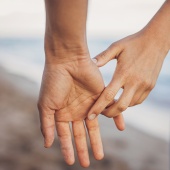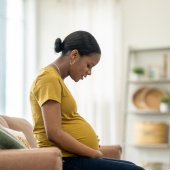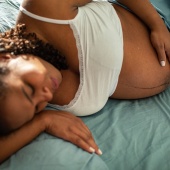Find out what perineal massage is and how it might help avoid a tear or episiotomy during birth.
What is the perineum?
The perineum (peri-NAY-um) is the area of skin and muscle between the vagina and anus.
The pressure of giving birth on the perineum means it may tear or need an episiotomy (eh-PEE-zee-otto-mee) when the baby is born. Up to 9 in 10 first time women and parents who have a vaginal birth have a graze, tear or episiotomy (NHS, 2023). Read more in our article about tearing and episiotomy.
Perineal massage is something that might help reduce tearing. Our NCT Antenatal courses talk about all aspects of pregnancy and birth, including why perineal massage might be beneficial.
Why is perineal massage recommended?
- Perineal massage helps prepare the perineum for childbirth. It makes the area more flexible, allowing it to stretch more easily during labour (Beckmann and Stock, 2013).
- Research shows that perineal massage can reduce the chances of a severe perineal tear or episiotomy during labour. This is particularly the case for women and people giving birth vaginally for the first time (Abdelhakim et al, 2020; Beckmann and Stock, 2013).
- It can shorten the second stage of labour and reduce perineal pain after birth. Additionally it leads to a decrease in anal incontinence (Abdelhakim et al, 2020).
- It reduces recovery time and the pain of recovery. This is because of the reduced tearing and chance of episiotomy (Abdelhakim et al, 2020 ; Beckmann et al, 2018).
What is perineal massage?
Perineal massage involves massaging the area between the vagina and anus during late pregnancy. Some pregnant women and people massage their perineum themselves, while others prefer to get their partner to help.
When can perineal massage start?
Perineal massage can be done daily from 35 weeks pregnant onwards (RCOG, no date).
Does it hurt?
Perineal massage may be uncomfortable and could sting or burn to begin with. This has usually gone by the second or third week of massage (Beckmann et al, 2013).
When should perineal massage be avoided?
If genital herpes, thrush, or another vaginal infection are suspected, talk to the midwife before starting perineal massage.
Avoid touching blisters or sores from genital herpes unless applying cream (NHS, 2023).
How do you do perineal massage?
Before starting (RCOG, no date):
- Some people like to sit in a warm bath to relax before they start the massage
- Wash hands
- Shorter fingernails are less likely to scratch the skin or cause discomfort
- Get into a comfortable position where the perineum can be easily reached, using pillows if needed
- Have a vitamin E, almond or vegetable oil to hand if using
If you’re performing perineal massage on yourself (RCOG, no date)
- Put your thumbs about 2.5cm to 4cm just inside the back wall of your vagina. This RCOG page has an illustration. You might find it easier to use a mirror the first few times.
- Press down towards your anus and to the sides until you feel the stretch.
- Hold this stretch for one minute while breathing deeply to help you relax.
- Gently massage the lower back wall of your vagina in a U shape. Do this for two to three minutes. Focus on relaxing your perineum.
- Repeat two or three times.
- Some people will focus the massage on any previous scar tissue. Massage can reduce stiffness and improve the elasticity of scars (Lubczyńska et al, 2023).
- Repeat daily or when possible. After a couple of weeks you will notice more elasticity.
If you’re performing perineal massage on your partner
- The pregnant woman or person might want to start doing the perineal massage themselves.
- When reaching the perineum is difficult, the partner could do the massage. This is if you both feel comfortable.
- Simply follow the same method as before. The only difference is that the partner will use clean index fingers rather than thumbs. They will apply side-to-side and U-shaped pressure towards the back wall of the vagina.
Should I use a pelvic floor training device as well?
In a single small Spanish study women chose whether to use massage, a training device, or nothing. The 100 women using the device received training on how to use it. They used it for 10 minutes each day starting from week 36 of pregnancy. Over time, they were able to get the device to open to 8.1cm on average.
Those using the device showed a reduction in episiotomy and the most severe tears (Artola Perez de Azanza et al, 2016).
Is there anything else I can do to prevent a tear or an episiotomy?
Keeping up pelvic floor exercises throughout pregnancy is a good idea. This helps keep your pelvic muscles strong during pregnancy and supportive after you give birth. You can release them during labour.
If you need further information about or support with perineal massage talk to your antenatal teacher, midwife or GP.
Further information
Our in-person NCT Antenatal courses give you up-to-date, evidence-based information to help you make decisions about your birth, your baby, your options.
Find out more about life after you've had a baby on our NCT New Baby course. It supports new parents and their babies, leaving you feeling confident, knowledgeable and relaxed.
Abdelhakim, A.M., Eldesouky, E., Elmagd, I.A. et al. (2020) Antenatal perineal massage benefits in reducing perineal trauma and postpartum morbidities: a systematic review and meta-analysis of randomized controlled trials. Int Urogynecol J 31, 1735–1745. https://doi.org/10.1007/s00192-020-04302-8
Artola Peres de Azanza et al (2016) Is the Epi-no device a tool for the prevention of perineal injuries of obstetric origin? Progress de Obstetrics and Gynaecology, 59(3):125-133. https://epi-no.co.uk/research-and-clinical-trials/ [24 Oct 24]
Beckmann M, Stock O. (2013) Antenatal perineal massage for reducing perineal trauma. Cochrane Database Syst Rev. (4):CD005123. https://doi.org/10.1002/14651858.CD005123.pub3
Lubczyńska A, Garncarczyk A, Wcisło-Dziadecka D. (2023) Effectiveness of various methods of manual scar therapy. Skin Res Technol. 29:e13272. https://doi.org/10.1111/srt.13272
NHS (2023a) Episiotomy and perineal tears. https://www.nhs.uk/pregnancy/labour-and-birth/what-happens/episiotomy-a… [24 Oct 24]
NHS (2023b) Genital herpes. https://www.nhs.uk/conditions/genital-herpes/ [24 Oct 24]
RCOG (no date) Reducing your risk of perineal tears. https://www.rcog.org.uk/for-the-public/perineal-tears-and-episiotomies-… [24 Oct 24]







